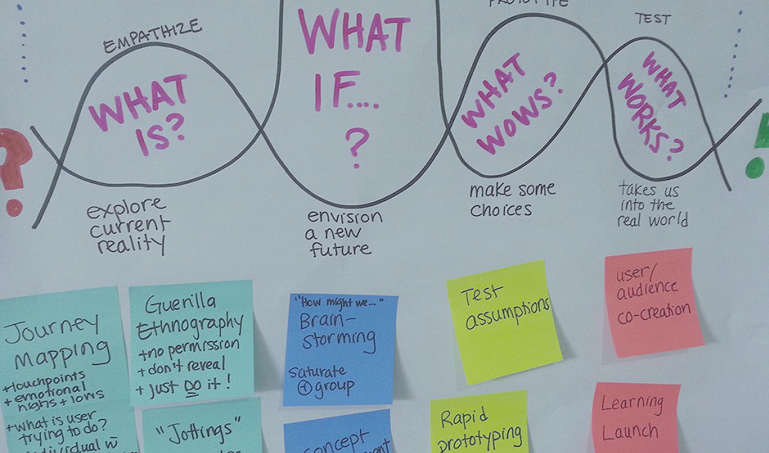Design Thinking: Simplifying and humanising innovation

Despite what some people might have you believe, there’s nothing ‘new’ about design thinking as a framework for encouraging, simplifying and humanising innovation. In fact, the methodology has been gradually evolving since the 1960s. Today though, we’re hearing more about design thinking than ever before. Indeed, in 2015, Harvard Business Review dedicated its entire issue to design thinking.
So what sets it apart from other approaches for unlocking innovation?
- It aids rapid ideation
- It is ideal for human-centred projects
- It helps to explore and unravel complexities
- It enables the collection and interpretation of qualitative data
- Without encouraging failure, it helps us realise that it’s rare ‘to get it right’ first time
All of the above help make design thinking a powerful tool for unlocking innovation within your team or your company.
At a recent Bench to Boardroom Seminar here at the Wellcome Genome Campus, a team from Sigma– a UX design agency based at the BioData Innovation Centre here on Campus gave us some expert tips on how to successfully apply design thinking to problem-solving, new product development, and innovation.
The masterclass
1. Ask yourself if you are addressing the right problem
This can be the trickiest question of all and is genuinely the start of any problem-solving process. It’s the old adage of ‘thinking outside of the box’ – advice that is actually incredibly hard to follow when you don’t know anything about the box. What size is it? What material is it made of? Is it already half full/empty? Does it need unpacking first? It can be very difficult to begin addressing a problem because it involves knowing what you don’t know- are you able to acknowledge your assumptions and challenge your biases from the outset?
Tip: Asking “How might we…” and “What if…” questions can help you generate new perspectives and approaches to solving your problem or that of your customer.
2. Get out of your building to prove yourself wrong
We all make assumptions and we do it pretty much all the time. It’s a seductive shortcut to take when embarking on a project, but this is often how an Achilles heel is introduced into your end solution. Design thinking is all about systematically exploring reality as opposed to relying on our mental models of it, and this is why to truly understand the problem, ethnographic research is essential. Consider, for example, a day out of the office-as Sigma did when they were first developing a solution for Juddmonte Farms in Newmarket (a racehorse breeder) for a new app that would help with scheduling and tracking movement of their animals around their various sites to help safeguard their horses. Sigma found it extremely helpful to visit the farm, where they found that contrary to the image of muddy stables set in the countryside, Juddmonte Farms is an ultra-modern looking compound, with clinically clean office spaces and precision-manicured flower beds and lawns. This, and the attention to detail that was evident everywhere on site was in sharp contrast to any assumption one might have had about a stud farm.
Tip: Ask yourself, or your boss “what stops us getting out there?”
3. Don’t’ ask people what they want
They don’t know. If you are trying to innovate, it’s important to remember that needs and wants are often very different, and on top of that, often a customer profile is different to that of an actual user and so the number of complexities can quickly build up as you start your new product development journey. Establishing the differences between the needs and wants early is an absolute must, particularly if you’re trying to disrupt and find a truly novel solution- not just to make something 20% better.
Tip: Dig deeper into what people ask for, watch their behaviour to unearth insights into their needs – this is where opportunity often hides.
4. Be open-minded
This is often trickier than it sounds and whilst most people would say they consider themselves open-minded countless research studies as well as the existence of the Implicit Attitude Test (IAT) methodology in research, for instance, suggests otherwise. This is something all adults do. As we pass through life, we are shaped by cultural biases and stereotypes, then coloured by our individual experiences and gathered knowledge, making it very difficult for us to transcend these powerful forces. This is how we build the tools that help us process thousands of decisions conducive to our own survival. This is often why we are not able to examine a problem from as many different angles as needed when we are designing a service or product that would appeal to those who will ultimately use it. Part of the power of design thinking is that it encourages experimentation. By inviting a diversity of voices, experiences and ideas you can explore more options, test assumptions and challenge the “This is how we always do this” way of thinking.
Tip: Start with a hypothesis. Think through the ways in which you can better involve people in what you do.
5. Consider it ‘done’ when it delivers value
Or in other words: Perfection is the enemy of ‘done’. Make sure that you use what you learn at the start of the design process to define what ‘done’ will look and feel like. What you make in the end has to be useful, viable, desirable and usable. Crucially, ask how it makes the user/customer feel- what is their experience of the process or a product? This is the step that is surprisingly often skipped, but it’s this information that validates your solution in the best possible way. Ask, learn and iterate.
Tip: Ask yourself how often you measure success or consider something ‘done’.
Are there any downsides to design thinking?
Perhaps. It depends on the existing culture, skills and personality mix within your team or company. In my experience, whilst spending a day out of the office armed with Sharpies and Post It notes generating ideas is enjoyable, capturing those ideas in a systematic and useable way for accessing and digesting post brainstorm takes an experienced human thought-wrangler. A psychologist, marketer, artist, designer, customer services and business development manager all rolled into one. A tall order indeed. The beauty of design thinking lies in its potency, the challenge is that it is often a time and resource-hungry endeavour, and therefore prone to being dismissed by those whose sole focus is on delivering to tight deadlines (and often skinny budgets).
But do it right, and design thinking can yield innovative results for companies large and small and in every sector from the largest multinational to the smallest start-up.
For more information about Sigma, their services and case studies, go to www.wearesigma.com
To find out when the next open to public Bench to Boardroom seminar is being hosted, please sign up to our events’ list.


